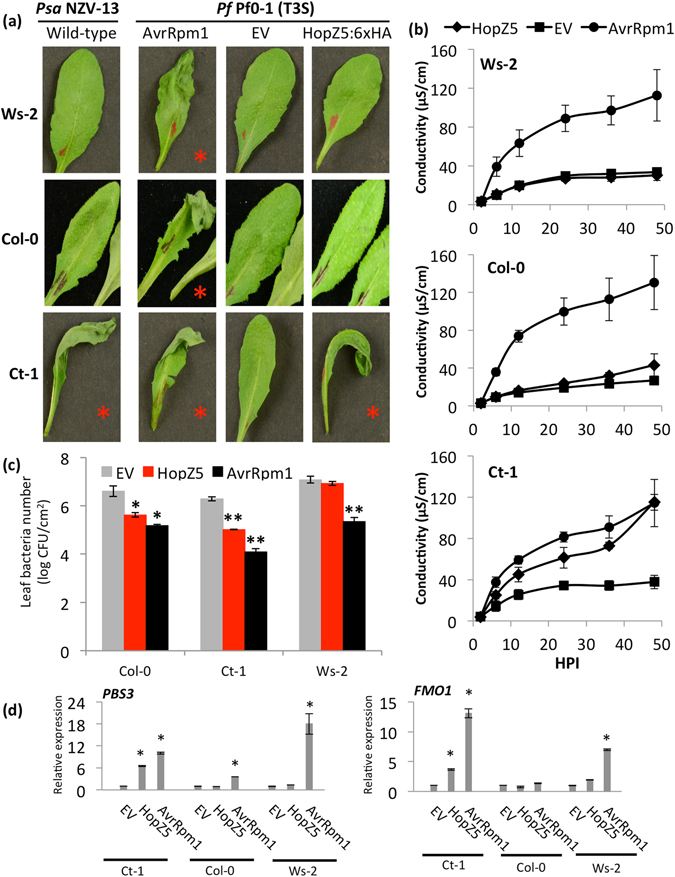Figure 1.

Pseudomonas syringae pv. actinidiae type III effector HopZ5 triggers accession-specific immunity in Arabidopsis. (a) Arabidopsis accession-dependent development of a hypersensitive response to P. syringae pv. actinidiae and its type-III secreted effector HopZ5. Leaves of Arabidopsis plants were infiltrated with P. syringae pv. actinidiae NZV-13 or P. fluorescens Pf0-1 (T3S) carrying an empty vector pBBR1MCS-5 (EV), hopZ5 with a C-terminal 6xHA tag under the control of the avrRps4 promoter in pBBR1MCS-5 or untagged avrRpm1 under its native promoter in pVSP61. Bacterial suspensions (1 × 108 CFU/mL) were blunt-syringe infiltrated into the leaves and photographs were taken 20 hours after infiltration (1 dpi). Development of the hypersensitive response is indicated by a red asterisk. (b) Electrolyte leakage from Arabidopsis leaf discs after infiltration with P. fluorescens Pf0-1 (T3S) carrying the indicated constructs, as in (a). Bacteria (1 × 108 CFU/mL) were blunt syringe-infiltrated into the leaves. The error bars indicate the standard error from four technical replicates. The experiment was conducted three times with similar results. (c) P. syringae pv. tomato DC3000 (Pto DC3000) growth in Arabidopsis. Pto DC3000 carrying EV, hopZ5-HA or avrRpm1 was blunt syringe-infiltrated at 5 × 105 CFU/mL into Arabidopsis leaves, and bacterial growth was determined 4 days post-infection (4 dpi). Error bars represent standard error from six technical replicates. Asterisks indicate results of Student’s t-test between selected sample and EV for that accession; *(P < 0.05), **(P < 0.01). The experiment was conducted six times with similar results. (d) Defence gene expression in Arabidopsis in response to EV, HopZ5-HA or AvrRpm1. P. fluorescens Pf0-1 (T3S) (1 × 108 CFU/mL) carrying EV, hopZ5-HA or avrRpm1 was blunt syringe-infiltrated into leaves, samples taken at 8 hours post infiltration and defence gene expression determined from extracted RNA by quantitative polymerase chain reaction. Expression for each defence gene is relative to internal EF1α expression and defence gene expression for EV samples indicated. Error bars indicate standard error from three technical replicates. Asterisks indicate results of Student’s t-test between selected sample and EV for that accession; *(P < 0.01). The experiment was conducted three times with similar results.
